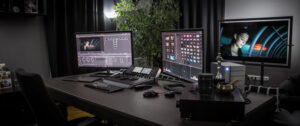Used by top Hollywood studios, DaVinci Resolve is powerful video editing software. Although it’s free, DaVinci Resolve puts up tough competition against other industry-leading video software, like Adobe Premiere Pro and Apple’s Final Cut Pro. Both of these come with hefty price tags and don’t offer as many post-production solutions in one space as DaVinci Resolve does.
Once the underdog, DaVinci Resolve has grown into a mature NLE capable of competing with industry standards like Final Cut, Avid and Premiere Pro. So much so that many long-time editors are making the switch.
In this post, we’re going to compare Resolve against the competition. Whether you’re considering learning Resolve, or are already an experienced user looking to better harness its unique strengths, we’re going to start with a look at the Resolve user interface, its feature-set, how it integrates with the rest of your post-production workflow and its cost — spoiler, it’s free!
Then, we’ll summarize Resolve’s strengths and weaknesses. And finally, we’ll answer the big question…should you start using it? check out the video below!
The Pro’s
1. Integration. Without a doubt, Resolve’s biggest strength is the integration of its industry-leading color correction tools. Edits made in Premiere, Final Cut Pro and Avid are regularly imported into Resolve for grading. If you’ve ever experienced the pain of conforming to edit, you’ll have asked yourself, why don’t I simply make the edit in Resolve in the first place!?
2. Cost. It’s cheap at worst, free at best.
3. Innovation. Blackmagic has innovated by re-thinking editing with the cut page, but they’ve not forced you to change. It’s there as an option if you want it.
4. It’s a Rising Star! It is growing in popularity, is very mature, has a wide user base and receives regular updates. Blackmagic makes a wide range of accessories for use with Resolve, including its keyboard, color grading consoles, video capture and output, and more. It’s a complete ecosystem you can buy into.
The Con’s
1. The Learning Curve. Those familiar with something like Adobe’s layer-based approach to compositing will find Resolve’s node-based workflow a bit confusing. It’s not hard to learn but plan to spend a little time uncovering its power and rewiring your brain a little.
2. No Dynamic Linking. Another Adobe comparison. While Resolve does have Fusion and Fairlight, Premiere’s integration with After Effects, Photoshop, Illustrator, Audition and other Adobe packages via Dynamic Linking is undeniably powerful. If those links between software are currently a part of your workflow, you’ll have an empty hole in your heart where they once lived.
3. It’s the Underdog. Resolve is the industry leader for color grading, but it Is the underdog in the world of editing. That means there’s less demand for Resolve editors commercially, there are fewer plugins available, etc. Of course, though, this Is changing.
Should You Switch to DaVinci Resolve for Creative Editing?
Switching from editing in Premiere or Avid to Resolve is pretty easy given that they all share the same track-based approach. You’ve got all the same tools, they might have different names, use different hotkeys or be in a different part of the interface…but there’s no quantum leap.
You don’t have to wire your brain a different way like you would if moving over to Final Cut Pro’s magnetic timeline. In fact, to facilitate the transition, you can customize Resolve to use Premiere Pro, Avid or Final Cut hotkeys instead of its own default key assignments.
The story’s a little different when it comes to color and Fusion. As mentioned, the biggest learning curve will be learning to use Resolve’s node-based color grading and compositing tools. While Lumetri wraps up the complexities of color grading in easy-to-use sliders and guides you through the process with its deliberately sequenced interface, Resolve gives you the keys to the workshop to let you play without supervision. Lumetri is quick to learn but ultimately limited. Resolve is slower to learn, but way more powerful. Expect to spend time learning how to use the color panel before you’ll be able to work quickly.
The same goes for Fusion. Its node-based approach is nothing like Adobe After Effects layer-based compositing!





